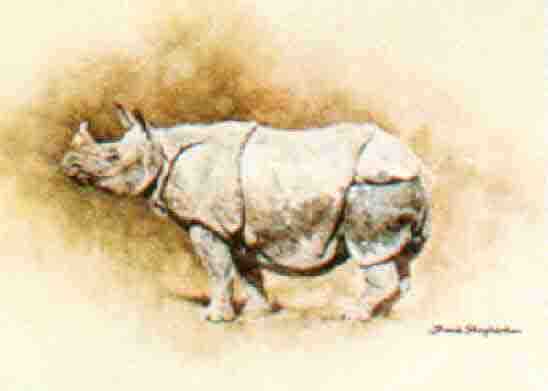Indian Rhino
David Shepherd

"Indian Rhino"
Signed Limited Edition of 850
Image Size:- 12.5" x 8.5"
Published 1980
In stock:- price; please call
A rhinoceros ( from Greek rhinokeros 'nose-horned', from rhis 'nose', and keras 'horn'),
commonly abbreviated to rhino, is a member of any of the five extant species (or numerous extinct species) of odd-toed ungulates in the family Rhinocerotidae.
(It can also refer to a member of any of the extinct species of the superfamily Rhinocerotoidea.)
Two of the extant species are native to Africa, and three to South and Southeast Asia.
Rhinoceroses are some of the largest remaining megafauna; all weigh at least one tonne in adulthood.
They have a herbivorous diet, small brains (400–600 g) for mammals of their size, one or two horns, and a thick (1.5–5 cm), protective skin formed from layers of collagen positioned in a lattice structure.
They generally eat leafy material, although their ability to ferment food in their hindgut allows them to subsist on more fibrous plant matter when necessary.
Unlike other perissodactyls, the two African species of rhinoceros lack teeth at the front of their mouths; they rely instead on their lips to pluck food.
Signed, limited edition, prints and original paintings, drawings for sale.
Cornwater Fine Art specialises in David Shepherd paintings and limited edition prints.30 years experience and a collection of hundreds of David Shepherd signed, limited edition prints in the UK!
Studio open, 7 days a week!Viewing by appointment
EMAIL:-administrator@davidshepherd.com
L.S. Lowry
russell flint
Back to David Shepherd main page prints for sale.